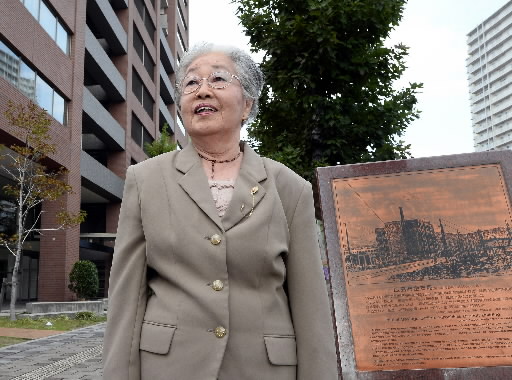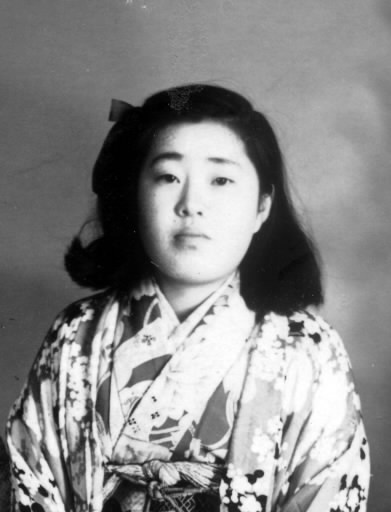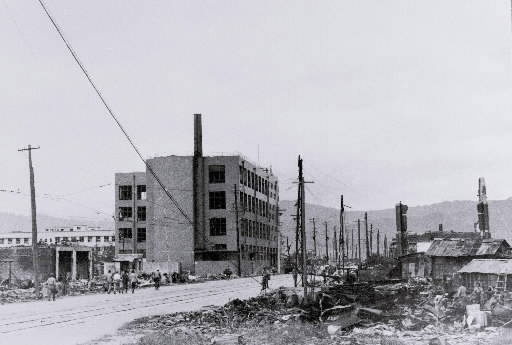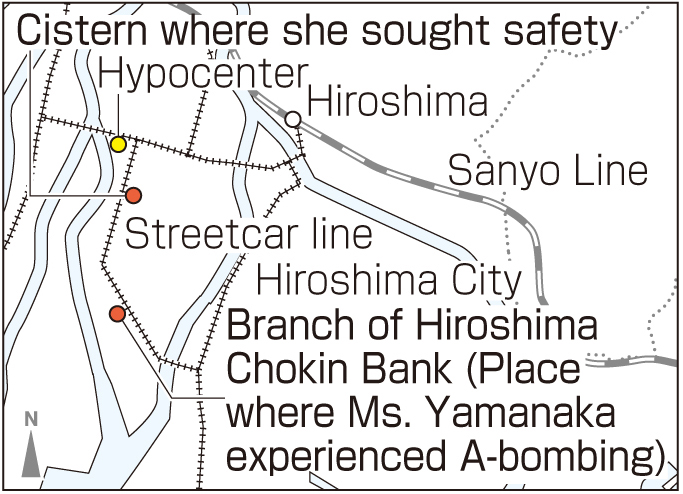Matsuko Yamanaka, 82, Nishi Ward, Hiroshima
Dec. 19, 2013
Sought refuge in a cistern to avoid the flames
A-bomb radiation wrought fatigue
At the time of the atomic bombing, Matsuko Yamanaka (nee Asakawa), 82, was at a branch of Hiroshima Chokin Bank in Sendamachi (part of present-day Naka Ward), about 1.6 kilometers from the hypocenter. She fled, unsure what was happening around her, and arrived at a water cistern used for fire fighting, roughly 500 meters southeast of the hypocenter. To avoid the flames and heat, she dived into the water and waited until the fires died down. The whirling flames and dark sky of that time are still seared in her memory.
Back then, Ms. Yamanaka was 14 years old, a third-year student at Hiroshima Girls Commercial School (now, Hiroshima Shoyo High School). She had been mobilized to work for the war effort at the bank in Sendamachi. On the morning of August 6, before the day’s work had begun, she went down to the basement to retrieve some documents, then continued up to the fourth floor. At that moment she was suddenly blown through the air and fell unconscious. When she came to, there was no one around.
She doesn’t recall how she escaped from the building, or what route she took in flight. She recalls, after plunging into the water cistern, that there was also an old woman with wounded arms and two men in the tank, too. As the temperature of the water rose, the men pumped in cold water, and when it began to rain, they covered the cistern with an iron sheet.
That evening, a civil defense volunteer came by and urged them to evacuate from the area. Ms. Yamanaka helped bring the old woman to Hiroshima Red Cross Hospital (in today’s Naka Ward).
Later, she headed to her aunt’s house in Ujina (part of present-day Minami Ward). There, however, she began vomiting continuously and was unable to sleep at all that night.
The following day she went to Yoshijima-honmachi (now part of Naka Ward), where her mother and sisters had already evacuated, and was reunited with her parents and these two sisters. But soon after she fainted and then lay in bed for several days.
Ms. Yamanaka had three younger brothers, and the middle brother experienced the bombing at their home in Takaramachi (part of present-day Naka Ward). He was treated at a first aid station at Niho National School (now Niho Elementary School in Minami Ward) and returned home in September. However, the oldest brother, who was helping to dismantle buildings to create a fire lane and the youngest brother, at home, died in the blast.
The only visible injuries Ms. Yamanaka suffered were cuts to her left arm and her feet, but she was hit hard by fatigue, one of the symptoms that struck A-bomb survivors.
After graduating from school, she married a coworker in 1950. Their eldest son works at the nuclear power plant in Fukushima Prefecture, where the accident in March 2011 occurred, and his house is located only about 10 kilometers from the power station. Residents of this area were forced to evacuate, and he now lives in a company dormitory, about 20-30 kilometers from the plant, and his wife lives elsewhere in temporary housing.
“I’m very concerned about harmful effects of the nuclear accident on my son,” Ms. Yamanaka said. “I understand well the horror of radiation, and because of this, I’m opposed to the use of nuclear energy.” This conviction is even stronger since the Great East Japan Earthquake of 2011. (Sakiko Masuda, Staff Writer)
Branch of Hiroshima Chokin Bank: Woman gives birth in basement amid bombing’s aftermath
Located in Sendamachi (part of present-day Naka Ward), the branch of Hiroshima Chokin Bank where Ms. Yamanaka worked was about 1.6 kilometers from the hypocenter. The building, completed in 1937, was made of ferroconcrete and consisted of four floors and a basement.
According to a record of the A-bomb damage in Hiroshima, the blast turned the building into a whirlwind of window glass, bookshelves, desks, and chairs, and many people were killed or injured. The elevator no longer worked, and when people dashed down the stairs, the handrails and walls were stained red with blood.
In a report made in 1995, the 50th anniversary of the atomic bombing, by the former Chugoku Postal Administration Office, which took over the operation of the branch, the names of 90 victims at the building, including those in a separate office in Fukuya Department Store (in Naka Ward), were confirmed.
In the aftermath of the bombing, the basement became a site of refuge. One woman who came to the basement seeking shelter ended up giving birth with the help of a midwife. Sadako Kurihara (1913-2005), a well-known poet from Hiroshima, heard this story and created the A-bomb poem “Umashimenkana” ("We Shall Bring Forth New Life").
The building underwent a series of repairs after the war, and was used for a long time, but finally was demolished in March of 1989.
Teenagers’ Impressions
I want friends all over the world
Ms. Yamanaka told us, “I want you to have a variety of experiences out in the world and make friends with the people you meet.” For a first step, I want to make friends with international students who are studying in Hiroshima. If everyone has friends all over the world, people wouldn’t want to wage war with countries where their friends live, and this could reduce the number of conflicts between nations. (Shiho Fujii, 12)
I want a society which doesn’t need nuclear energy
Ms. Yamanaka’s eldest son is working at the Fukushima No.1 (Daiichi) nuclear power plant. She is opposed to nuclear energy because there isn’t a good method for disposing of the spent nuclear fuel. However, nuclear energy enables her son to make a living so she says she has mixed feelings. I don’t want people to feel torn in this way, so I want us to conserve energy and create a society that doesn’t need nuclear power. (Yuka Ichimura, 17)
Staff Writer’s Notebook
Except for family and close friends, our interview was the first time that Ms. Yamanaka had shared her experience of the atomic bombing. The bombing stole the lives of two younger brothers and damaged her own health so these memories are very painful for her.
Still, she readily agreed to our request for an interview because she wants young people to know how foolish it is for human beings to kill one another in war. She told us with conviction, “I don’t want children to feel the kind of pain that we experienced, those of us who suffered so much because of the atomic bombing.”
She added, “If people don’t recognize the cruelty of war, the same mistakes will be repeated.” More than 68 years after the atomic bombing, Ms. Yamanaka’s words should be strongly heeded. (Sakiko Masuda)
(Originally published on December 10, 2013)
A-bomb radiation wrought fatigue
At the time of the atomic bombing, Matsuko Yamanaka (nee Asakawa), 82, was at a branch of Hiroshima Chokin Bank in Sendamachi (part of present-day Naka Ward), about 1.6 kilometers from the hypocenter. She fled, unsure what was happening around her, and arrived at a water cistern used for fire fighting, roughly 500 meters southeast of the hypocenter. To avoid the flames and heat, she dived into the water and waited until the fires died down. The whirling flames and dark sky of that time are still seared in her memory.
Back then, Ms. Yamanaka was 14 years old, a third-year student at Hiroshima Girls Commercial School (now, Hiroshima Shoyo High School). She had been mobilized to work for the war effort at the bank in Sendamachi. On the morning of August 6, before the day’s work had begun, she went down to the basement to retrieve some documents, then continued up to the fourth floor. At that moment she was suddenly blown through the air and fell unconscious. When she came to, there was no one around.
She doesn’t recall how she escaped from the building, or what route she took in flight. She recalls, after plunging into the water cistern, that there was also an old woman with wounded arms and two men in the tank, too. As the temperature of the water rose, the men pumped in cold water, and when it began to rain, they covered the cistern with an iron sheet.
That evening, a civil defense volunteer came by and urged them to evacuate from the area. Ms. Yamanaka helped bring the old woman to Hiroshima Red Cross Hospital (in today’s Naka Ward).
Later, she headed to her aunt’s house in Ujina (part of present-day Minami Ward). There, however, she began vomiting continuously and was unable to sleep at all that night.
The following day she went to Yoshijima-honmachi (now part of Naka Ward), where her mother and sisters had already evacuated, and was reunited with her parents and these two sisters. But soon after she fainted and then lay in bed for several days.
Ms. Yamanaka had three younger brothers, and the middle brother experienced the bombing at their home in Takaramachi (part of present-day Naka Ward). He was treated at a first aid station at Niho National School (now Niho Elementary School in Minami Ward) and returned home in September. However, the oldest brother, who was helping to dismantle buildings to create a fire lane and the youngest brother, at home, died in the blast.
The only visible injuries Ms. Yamanaka suffered were cuts to her left arm and her feet, but she was hit hard by fatigue, one of the symptoms that struck A-bomb survivors.
After graduating from school, she married a coworker in 1950. Their eldest son works at the nuclear power plant in Fukushima Prefecture, where the accident in March 2011 occurred, and his house is located only about 10 kilometers from the power station. Residents of this area were forced to evacuate, and he now lives in a company dormitory, about 20-30 kilometers from the plant, and his wife lives elsewhere in temporary housing.
“I’m very concerned about harmful effects of the nuclear accident on my son,” Ms. Yamanaka said. “I understand well the horror of radiation, and because of this, I’m opposed to the use of nuclear energy.” This conviction is even stronger since the Great East Japan Earthquake of 2011. (Sakiko Masuda, Staff Writer)
Hiroshima Insight
Branch of Hiroshima Chokin Bank: Woman gives birth in basement amid bombing’s aftermath
Located in Sendamachi (part of present-day Naka Ward), the branch of Hiroshima Chokin Bank where Ms. Yamanaka worked was about 1.6 kilometers from the hypocenter. The building, completed in 1937, was made of ferroconcrete and consisted of four floors and a basement.
According to a record of the A-bomb damage in Hiroshima, the blast turned the building into a whirlwind of window glass, bookshelves, desks, and chairs, and many people were killed or injured. The elevator no longer worked, and when people dashed down the stairs, the handrails and walls were stained red with blood.
In a report made in 1995, the 50th anniversary of the atomic bombing, by the former Chugoku Postal Administration Office, which took over the operation of the branch, the names of 90 victims at the building, including those in a separate office in Fukuya Department Store (in Naka Ward), were confirmed.
In the aftermath of the bombing, the basement became a site of refuge. One woman who came to the basement seeking shelter ended up giving birth with the help of a midwife. Sadako Kurihara (1913-2005), a well-known poet from Hiroshima, heard this story and created the A-bomb poem “Umashimenkana” ("We Shall Bring Forth New Life").
The building underwent a series of repairs after the war, and was used for a long time, but finally was demolished in March of 1989.
Teenagers’ Impressions
I want friends all over the world
Ms. Yamanaka told us, “I want you to have a variety of experiences out in the world and make friends with the people you meet.” For a first step, I want to make friends with international students who are studying in Hiroshima. If everyone has friends all over the world, people wouldn’t want to wage war with countries where their friends live, and this could reduce the number of conflicts between nations. (Shiho Fujii, 12)
I want a society which doesn’t need nuclear energy
Ms. Yamanaka’s eldest son is working at the Fukushima No.1 (Daiichi) nuclear power plant. She is opposed to nuclear energy because there isn’t a good method for disposing of the spent nuclear fuel. However, nuclear energy enables her son to make a living so she says she has mixed feelings. I don’t want people to feel torn in this way, so I want us to conserve energy and create a society that doesn’t need nuclear power. (Yuka Ichimura, 17)
Staff Writer’s Notebook
Except for family and close friends, our interview was the first time that Ms. Yamanaka had shared her experience of the atomic bombing. The bombing stole the lives of two younger brothers and damaged her own health so these memories are very painful for her.
Still, she readily agreed to our request for an interview because she wants young people to know how foolish it is for human beings to kill one another in war. She told us with conviction, “I don’t want children to feel the kind of pain that we experienced, those of us who suffered so much because of the atomic bombing.”
She added, “If people don’t recognize the cruelty of war, the same mistakes will be repeated.” More than 68 years after the atomic bombing, Ms. Yamanaka’s words should be strongly heeded. (Sakiko Masuda)
(Originally published on December 10, 2013)











